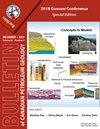Modeling strain across mechanical sedimentary lithologic interfaces: geomechanical models derived from outcrop analysis
Q3 Earth and Planetary Sciences
引用次数: 4
Abstract
In the brittle crust, the distribution of natural rock fractures and their failure modes are a function of rock strength and its interactions between overburden pressure, pore-fluid pressure, and tectonic loading. The characterization of variability in rock strength and the associated changes in subsurface strain distribution is especially important for modeling the response of low-permeability rocks to changes in effective stress. This paper documents the effect variations in elastic mechanical properties have on the nature and distribution of fractures in the subsurface. Outcrop and geophysical wireline log evaluation of the Jurassic Carmel Formation and Navajo Sandstone was used to identify mechano-stratigraphic units and model subsurface strain distribution within sedimentary successions and across sedimentary interfaces. Two finite element models were constructed and populated with elastic moduli derived from geophysical wireline data in order to understand where natural fractures form in rocks with varying layer thickness and elastic properties. Strain distribution results from a 3-layer and a 5-layer model are compared to the natural deformation response visible in outcrop. Model results show that more fractures are expected in high strain regions and fewer fractures in low strain regions. Strain variations are observed in both model scenarios and occur at material interfaces. The simple 3-layer model results in a smoothing of strain variations, while the 5-layer model captures strain variations that more closely match the fracture density observed in outcrop. Results from the 5-layer model suggests an interplay between Young’s modulus and Poisson’s ratio and that high strain regions form in thin (1-m thick) layers with moderate Young modulus (17.2 GPa) and Poisson ratio (0.26) values. Outcrop observations and modeling results indicate that the potential for subsurface failure and fluid flow would not be restricted to the low fracture strength units but can cut vertically across interfaces of varying mechanical strength. Results from this work indicates that these types of models can be used to identify stratigraphic layers that are more prone to mechanical failure or identify layers that have more natural fractures or are more likely to form induced fractures.模拟跨力学沉积岩性界面的应变:由露头分析得出的地质力学模型
在脆性地壳中,天然岩石裂缝的分布及其破坏模式是岩石强度及其与覆盖层压力、孔隙流体压力和构造载荷相互作用的函数。对于模拟低渗透岩石对有效应力变化的响应,岩石强度变异性的表征以及与之相关的地下应变分布的变化尤为重要。本文记录了弹性力学性能的变化对地下裂缝的性质和分布的影响。利用侏罗纪Carmel组和Navajo砂岩的露头和地球物理电缆测井评价,确定了沉积序列和沉积界面内的力学地层单元和模拟地下应变分布。为了了解具有不同层厚和弹性特性的岩石中天然裂缝的形成位置,研究人员构建了两个有限元模型,并填充了来自地球物理电缆数据的弹性模量。将3层模型和5层模型的应变分布结果与露头自然变形响应进行了比较。模型结果表明,高应变区裂缝较多,低应变区裂缝较少。在两种模型情况下都观察到应变变化,并且发生在材料界面上。简单的3层模型可以平滑应变变化,而5层模型捕获的应变变化更接近露头观察到的裂缝密度。五层模型的结果表明,杨氏模量和泊松比之间存在相互作用,高应变区形成于杨氏模量(17.2 GPa)和泊松比(0.26)适中的薄层(1 m厚)。露头观测和模拟结果表明,地下破坏和流体流动的可能性并不局限于低断裂强度单元,而是可以垂直穿过不同机械强度的界面。这项工作的结果表明,这些类型的模型可用于识别更容易发生机械破坏的地层,或识别具有更多天然裂缝或更可能形成诱导裂缝的地层。
本文章由计算机程序翻译,如有差异,请以英文原文为准。
求助全文
约1分钟内获得全文
求助全文
来源期刊

Bullentin of Canadian Petroleum Geology
Earth and Planetary Sciences-Geochemistry and Petrology
CiteScore
2.50
自引率
0.00%
发文量
0
期刊介绍:
The Bulletin of Canadian Petroleum Geology is a peer-reviewed scientific journal published four times a year. Founded in 1953, the BCPG aims to be the journal of record for papers dealing with all aspects of petroleum geology, broadly conceived, with a particularly (though not exclusively) Canadian focus. International submissions are encouraged, especially where a connection can be made to Canadian examples.
 求助内容:
求助内容: 应助结果提醒方式:
应助结果提醒方式:


